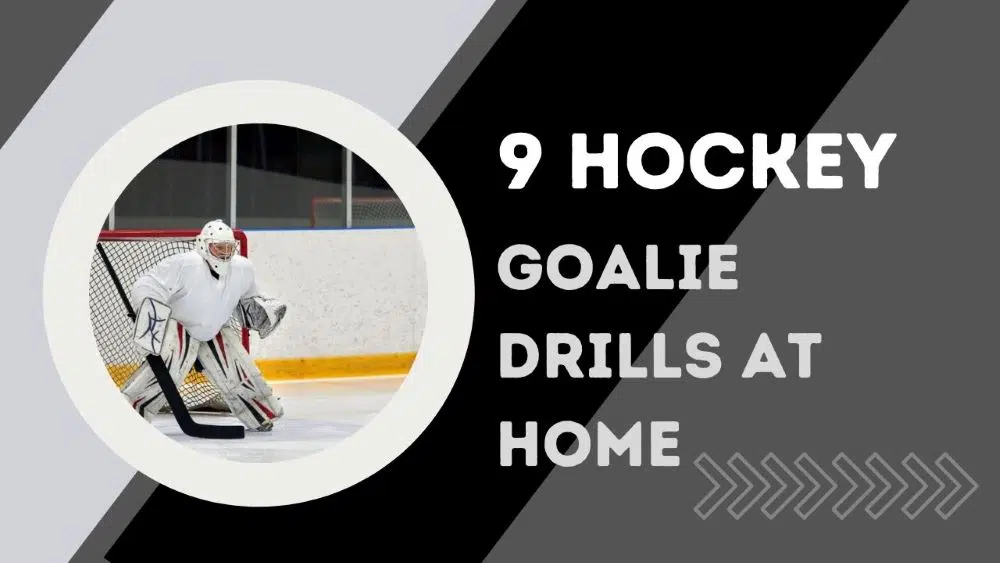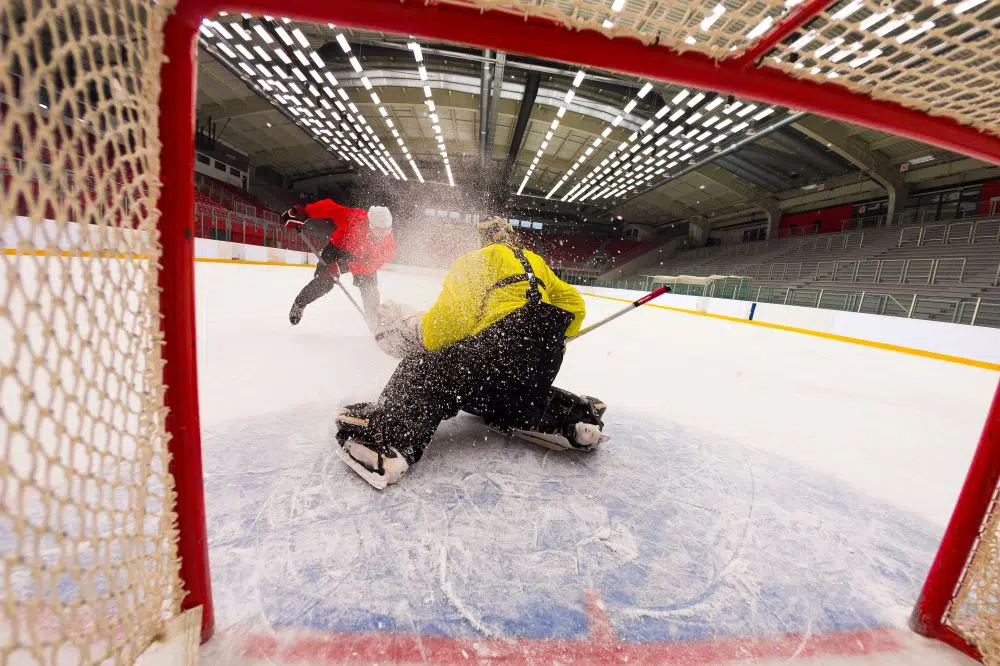Are you an ice hockey fanatic looking to spruce up your skills off-ice? Well, I’ve got good news for you!
Hockey enthusiasts can easily adapt many of the drills to a non-ice environment (Source), and you don’t need ice to practice your goalie moves at home.
With these top 9 ice hockey goalie drills, you can enhance your goalie capabilities and challenge your playing strengths like never before!

Warm Up and Effective Prep
Before executing any of these drills, make sure you warm-up and get your body used to the rhythm. This greatly helps in enhancing your performance and minimizing the risk of injury such as muscle sprains (source).
You can warm up by:
- Performing simple stretches. You can perform these anywhere in your home, adjusting the sets and reps as you like. You can also include a yoga mat to help you.
- Do 50 to 100 jumping jacks. They get your heart rate going and are a great warm-up exercise.
- Jump rope about 100 times.
For additional efficiency, you can perform your warm-up exercises while wearing your gear such as helmet and knee pads, and can also practice carrying your stick.
9 Ice Hockey Goalie Drills To Do At Home
1. MB Push Pass to Push Up
Fun, exciting, and unique, this fast-paced drill is my top pick for this list.
It helps you practice several skills at once and breaks up the monotony of training, as it involves a fast medicine ball coming straight toward your head!
Sure, I admit this sounds a little weird, but this drill is highly effective in increasing your reaction speed, which is the topmost skill any goalie can have.
To perform this drill, you will have to get in a kneeling position in front of a solid wall and pass the ball towards the wall from this position.
As soon as you throw the ball, get down to your chest into a plyometric position. Push off the ground with enough force to get back in the kneeling position before the ball bounces back.
Tough and quick, this drill is bound to challenge your goalkeeping capabilities.
2. Bilateral Knee Recovery
This butterfly goalie drill puts a strong emphasis on lateral power and vertical transitions.
It caters to an area that most goalies struggle with on the ice – how to pop back up on your skates quickly and smoothly from a butterfly position.
This drill will not only help you bounce back on your feet safely and easily but also allow you to channel peak lightning-speed goalie energy!
3. Small Ball
This drill is similar to the MB Push Pass drill, involving a ball and a wall. You can perform this by standing face to face with a solid wall, at a distance of about 10 feet, and throwing a small rubber ball at the wall.
The objective of this drill is to stop the ball from getting past you.
You can do this drill alone, or have someone else throw the ball for you, as long as you start from your standing position when the ball is thrown. You can also perform this drill fully clad in your goalkeeping equipment, helping increase your quickness and familiarizing yourself with moving in your player gear.
4. The Soccer-Hockey Hybrid
This fun drill combines hockey and soccer in one and improves your reaction time and stick work massively. You will need to stand facing a wall, keeping a distance of about 10 feet.
You will need a soccer ball or another type of ball of similar size.
Kick the ball to the wall, making sure to keep moving the wall back and forth by only using your legs. If you miss a shot, you’ll have to start the drill all over again.
Set a goal for yourself with regards to the number of successive times you need to strike the ball, and once you’ve achieved it, lessen the distance between yourself and the fall. You can do this drill without a stick, and it significantly improves your ability to direct the puck off your pads.

5. Triangle Hop with MB Hand-to-Hand Pass
This drill can be performed without a medicine ball, but I believe adding the ball increases the difficulty level of this drill and makes it more exciting.
Use your T-pushes as you patrol your crease staying square to the shooters. Start at one post, and then work your way up by T-pushing to the top of the crease.
Keep a strong ready position with your torso when performing this drill off the ice, and remember to use your leg strength and not your trunk to move.
6. Use Your Head
Start this drill by facing a wall about 20 feet away from you. You can ask for a team player’s help to throw a small rubber ball high against the wall.
As the ball bounces towards you through the air, keep your eyes on it. You can move your head to follow the ball with your eyes, but cannot raise your stick. Move if you need to, as long as you’re centered with the ball, but do not let it get past you.
This drill is bound to improve your hand-eye coordination and reaction time. It allows you to practice following the ball movement from player to player, making it easier for you to respond well when it heads towards you in a real game-like scenario.
7. Lateral Hop and Stick with Eyes Closed
Working on developing a strong balance is vital for any goalkeeper, and this goalie drill will exercise you thoroughly and give you good mileage.
In a general ice hockey game, when you are tracking the puck and making sudden movements, your vestibular or balance system can get overworked.
As your head is moving in one direction and your body in another, it can get difficult to establish that perfect point of balance on the ice.
You can counter this problem by performing simple balance movements with your stick, keeping your eyes closed.
Doing these motions without your vision forces your body to rely on your nerve endings and senses to determine distance and body position instead of interpreting visual input. With time, your body can fine-tune its reactions to any stimuli, and in a real game, you will be able to stay in a stable position much better, ready to execute your next play.
Make sure to not overcomplicate this drill as it can increase the risk of injury. Start off with small hops and movements only, and keep on adding to the drill once you get better.
8. Up Up, Down Down
Most goalies struggle with getting back to a normal stance from a kneeling position, and this drill specifically helps counter that problem.
You simply need to get into a kneeling position and then back upright on your blades quickly and repeatedly in the execution of this drill.
The objective of this drill is to help you get back on your feet as quickly as possible without sacrificing the defending goalie stance.
9. Up Up Down Down with Catch and Pass
This is simply a different version of the previous drill.
With an added element of hand-eye coordination in this off-ice goalie drill, it helps you focus on stopping the puck alongside executing your movements with balance, speed, and precision.
To execute this drill, simply keep up with the up-down movements continuously, while simultaneously bouncing a ball off a wall. Make sure you switch your hands and positions repeatedly to make the drill more effective.
Pro Tip: Goalie is not like any other position on the ice-not even close. So, to stay in top condition you have to work out differently than other players. Check out these goalie specific workouts:
Final Thoughts
Play around with these nine amazing off-ice goalie drills (and the pro workout), making sure to include any critique or advice you receive from your team members and goalie coach in your practice routines.
The above drills will not only help you develop the speed, stamina, and skill set you need to put up a strong defense, but are also a fun way to spice up a boring ice hockey practice session.
With the ongoing coronavirus pandemic, most players do not have access to ice rings, and these drills are perfect for performing at home. So make sure you stay up to date with your ice hockey goalie practice and remember to have some fun while you’re at it!
For a visual explanation of puck training and some great off-ice hockey drills, click here to watch the video.
Thank you for reading thus far, and I hope these drills are helpful for practice.
